Want it delivered daily to your inbox?
-
Some forecasters are currently predicting that 10-year rates will end the year above 5%, others are predicting a level below 3%, and the chart below shows the standard deviation of the 12-month ahead forecast for 10-year Treasury yields for 26 private sector forecasters since 2019.
The rising trend in the standard deviation of forecasts shows a very high level of disagreement among forecasters about what will happen to long-term interest rates in 2024.
This is not surprising because some would argue that a soft landing with Fed cuts and lower inflation would result in lower long-term interest rates.
Others would argue that a soft landing with no recession and the risk of reacceleration will push rates higher.
On a different note, others would argue that the key driver of rates in 2024 will be a higher term premium, driven by the coming massive increase in the supply of Treasuries.
What is most remarkable about the high level of disagreement among forecasters is that the same elevated level of uncertainty is entirely absent in the MOVE Index and the VIX Index.
The bottom line is that we have a busy year ahead of us in markets with extreme disagreement about the forces driving longer-term interest rates.
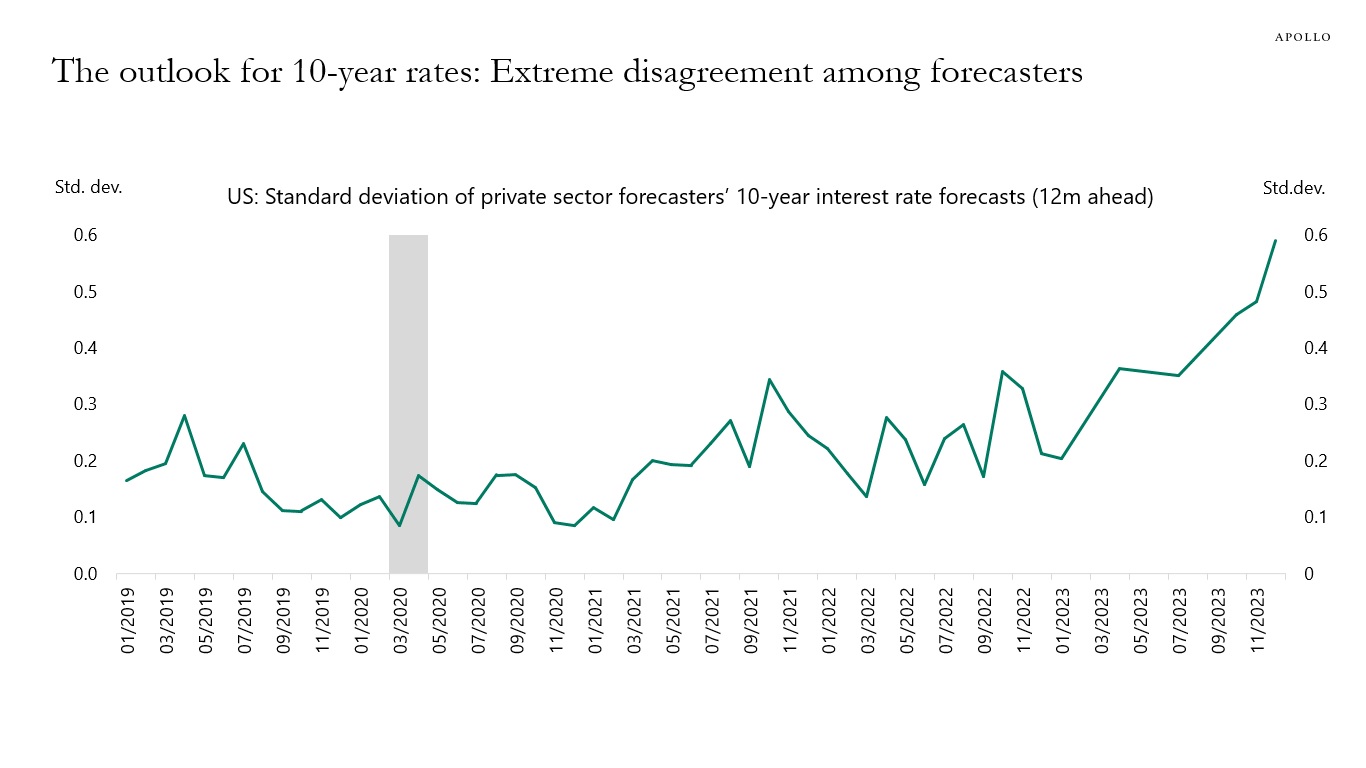
Source: Bloomberg, Apollo Chief Economist. (Note: We calculated standard deviation of individual analyst’s forecast for 12 months ahead for every month starting January 2019. The list of contributors in our calculation: UBS, Citigroup, HSBC holdings, Wells Fargo & Co, University Of Texas At El Paso, RBC Financial Group, Natixis SA, Naroff Economic Advisors, Mortgage Bankers Association, MacroFin Analytics LLC, Kasikornbank PCL, ING Groep NV, First Trust Advisors LP, Fannie Mae, Desjardins Securities Inc, Dai-ichi Life Research Institute Inc, Commerzbank, Action Economics, ABN Amro, Bank of Montreal, TD securities, Nomura, Barclays, Goldman Sachs, Bank of America, and Hamburg Commercial Bank AG.) See important disclaimers at the bottom of the page.
-
The market cap of the Magnificent Seven is now four times the market cap of the entire Russell 2000, see the first chart below.
And the market cap of the Magnificent Seven is the same size as the market cap of the stock markets in the UK, Canada, and Japan combined, see the second chart below.
Microsoft alone is the size of the entire stock market in Canada.
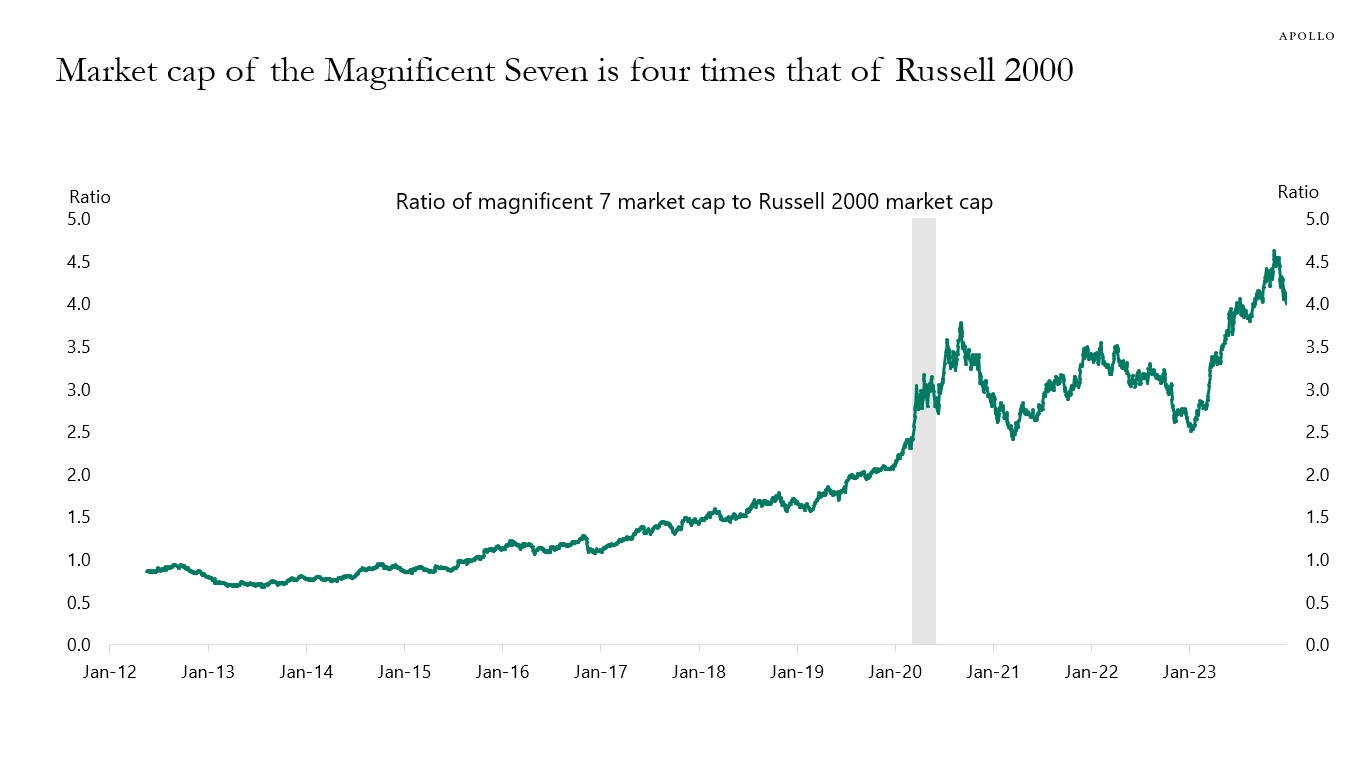
Source: Bloomberg, Apollo Chief Economist 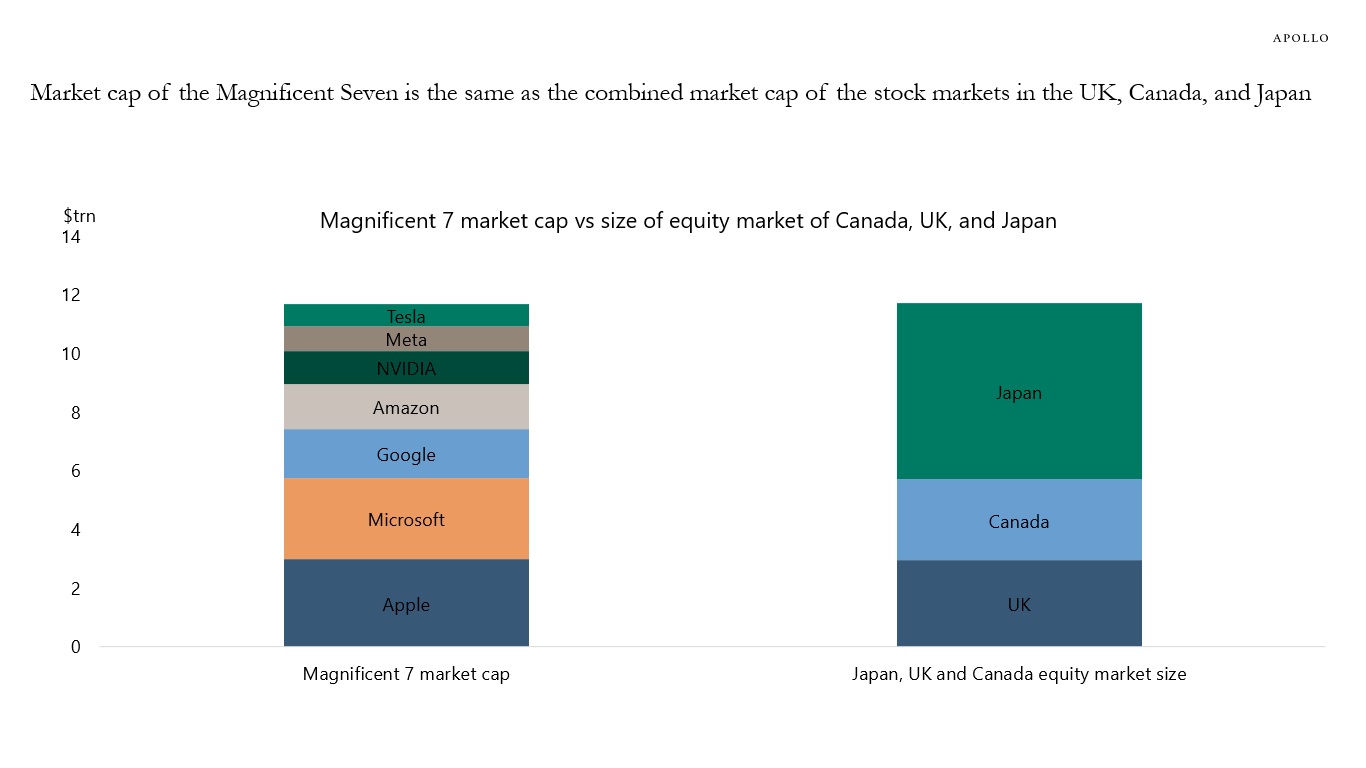
Source: Bloomberg, Apollo Chief Economist See important disclaimers at the bottom of the page.
-
Data covering the period after the Fed pivot shows that US consumers significantly changed their expectations to interest rates after the December FOMC meeting. Specifically, the share of consumers expecting interest rates to go down jumped to levels last seen during the pandemic and during the financial crisis in 2008, see chart below. With almost 30% of households expecting interest rates to go down, it would make sense if consumers now start borrowing and spending at a faster pace.

Source: U. of Michigan Survey, Haver Analytics, Apollo Chief Economist See important disclaimers at the bottom of the page.
-
Fed cuts and lower costs of capital could boost private markets in 2024. Our latest chart book is available here.
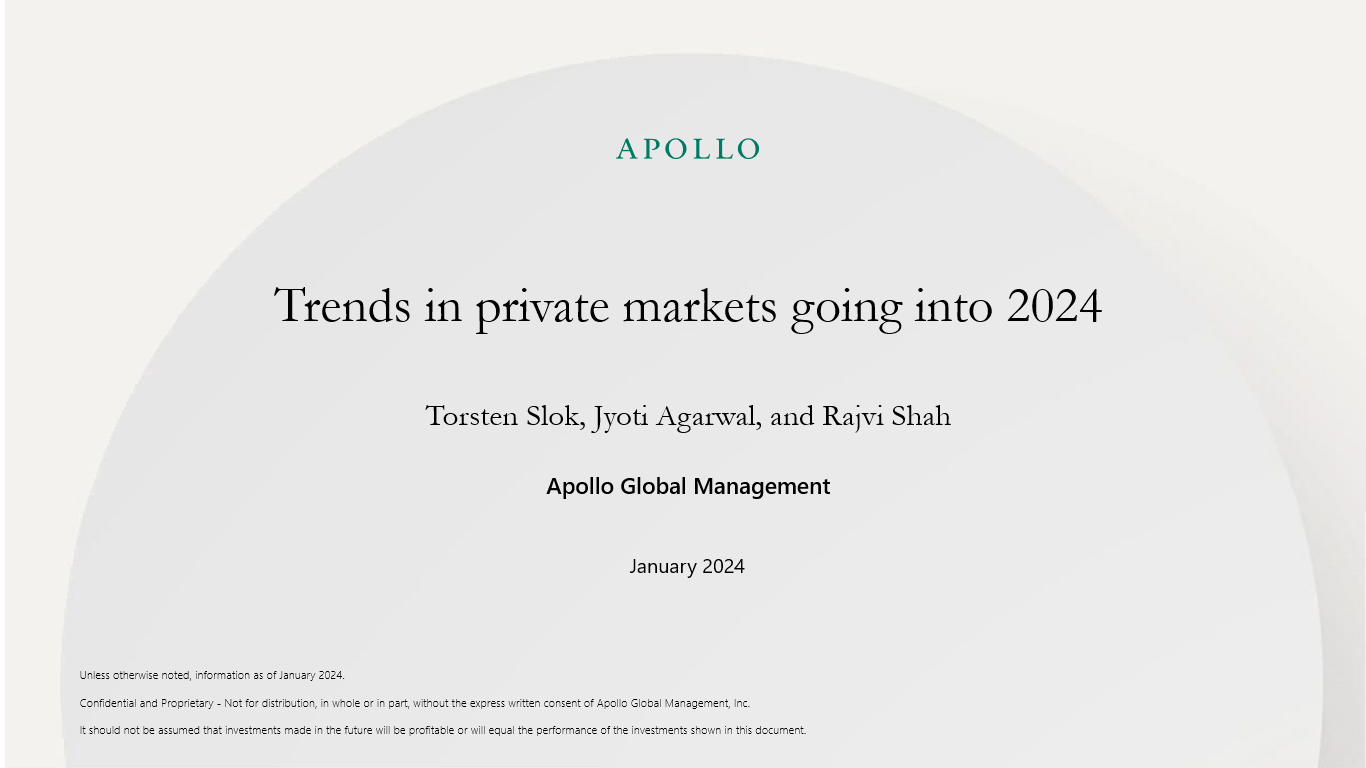
See important disclaimers at the bottom of the page.
-
The banking sector is facing a number of headwinds from a 40% decline in the price per square foot for office because of higher interest rates and more people working from home, $3 trillion in CRE holdings, and $684 billion in unrealized losses on Treasuries and mortgages, see charts below. The net result is a continued decline in the weekly data for bank lending, see the last chart below.
Our latest banking sector chart book is available here.

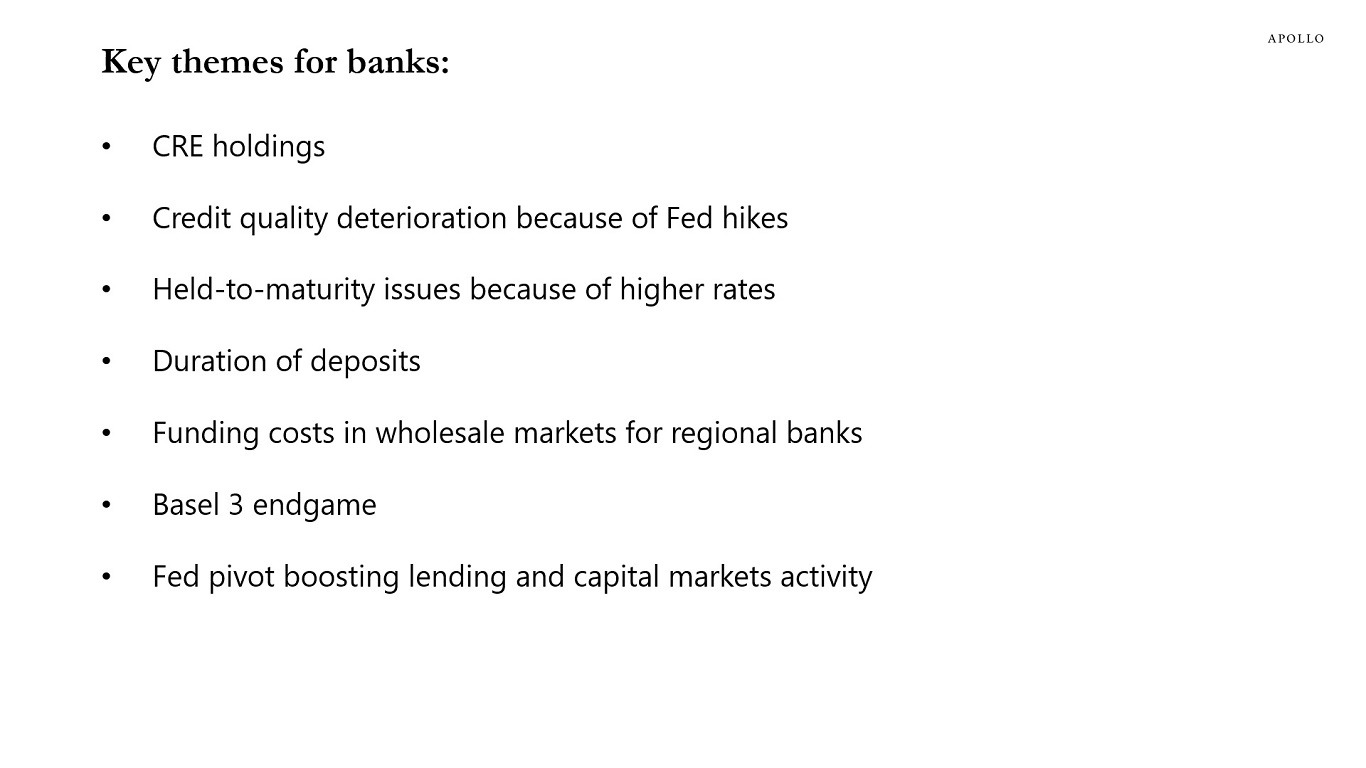
Source: Apollo Chief Economist 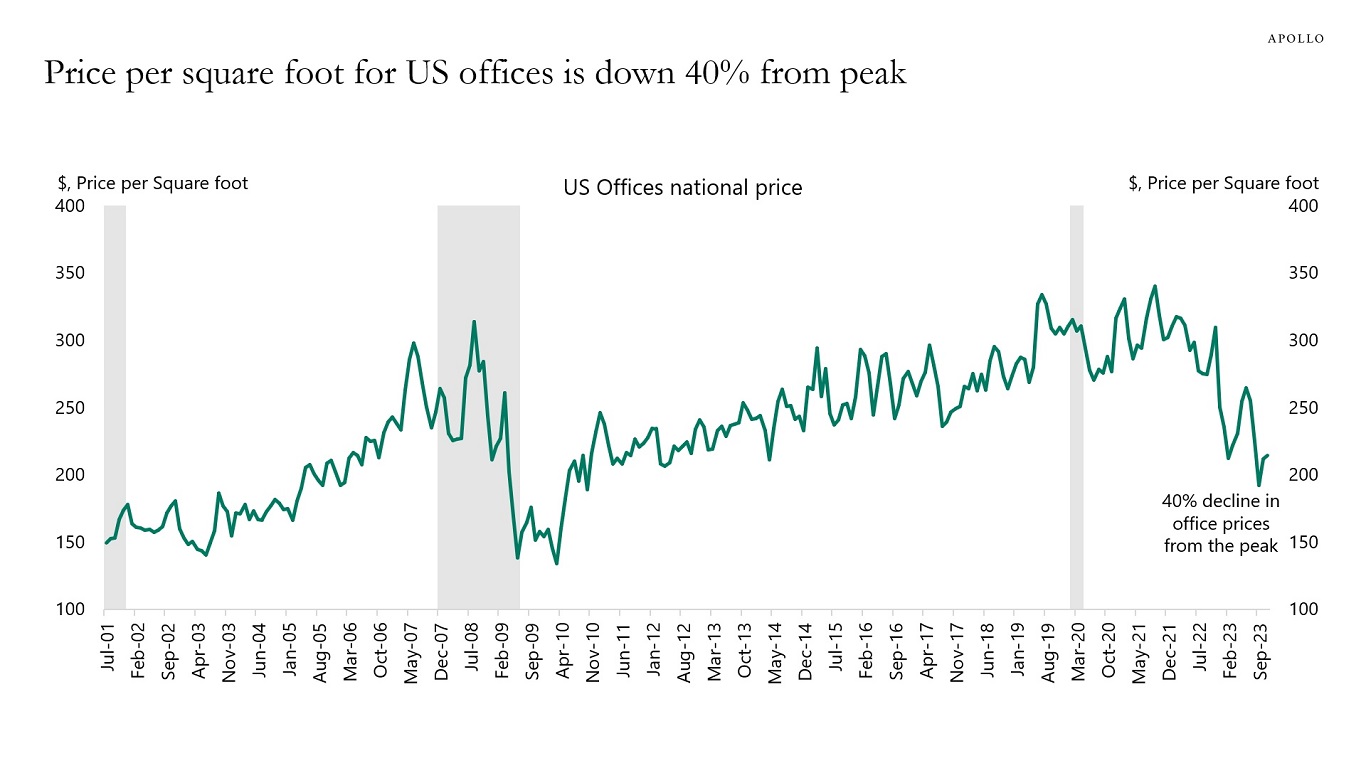
Source: RCA, Bloomberg, Apollo Chief Economist 
Source: REITS, BLS, Bloomberg, Apollo Chief Economist (Note: Office using employment includes professional and business services, Information and Financial activities) 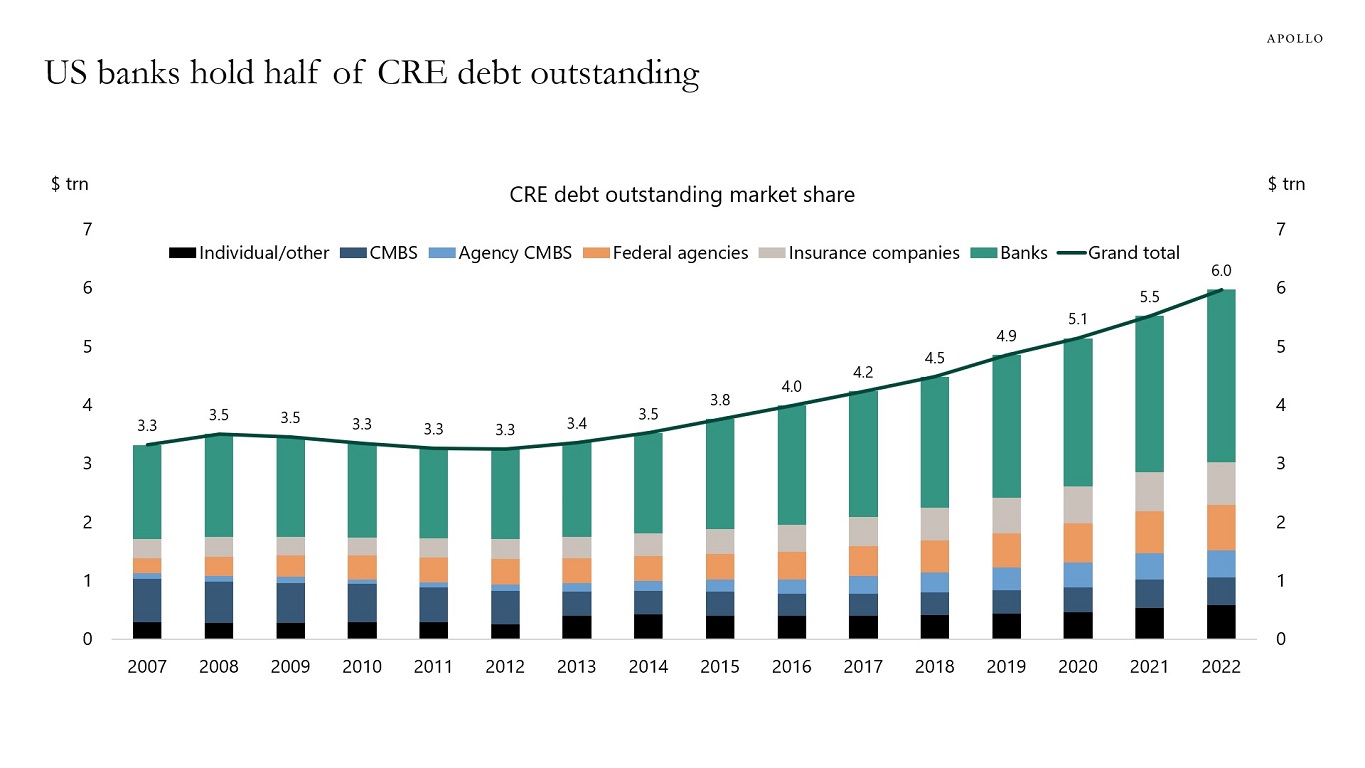
Source: S&P Capital IQ, Apollo Chief Economist 
Source: FDIC, Apollo Chief Economist 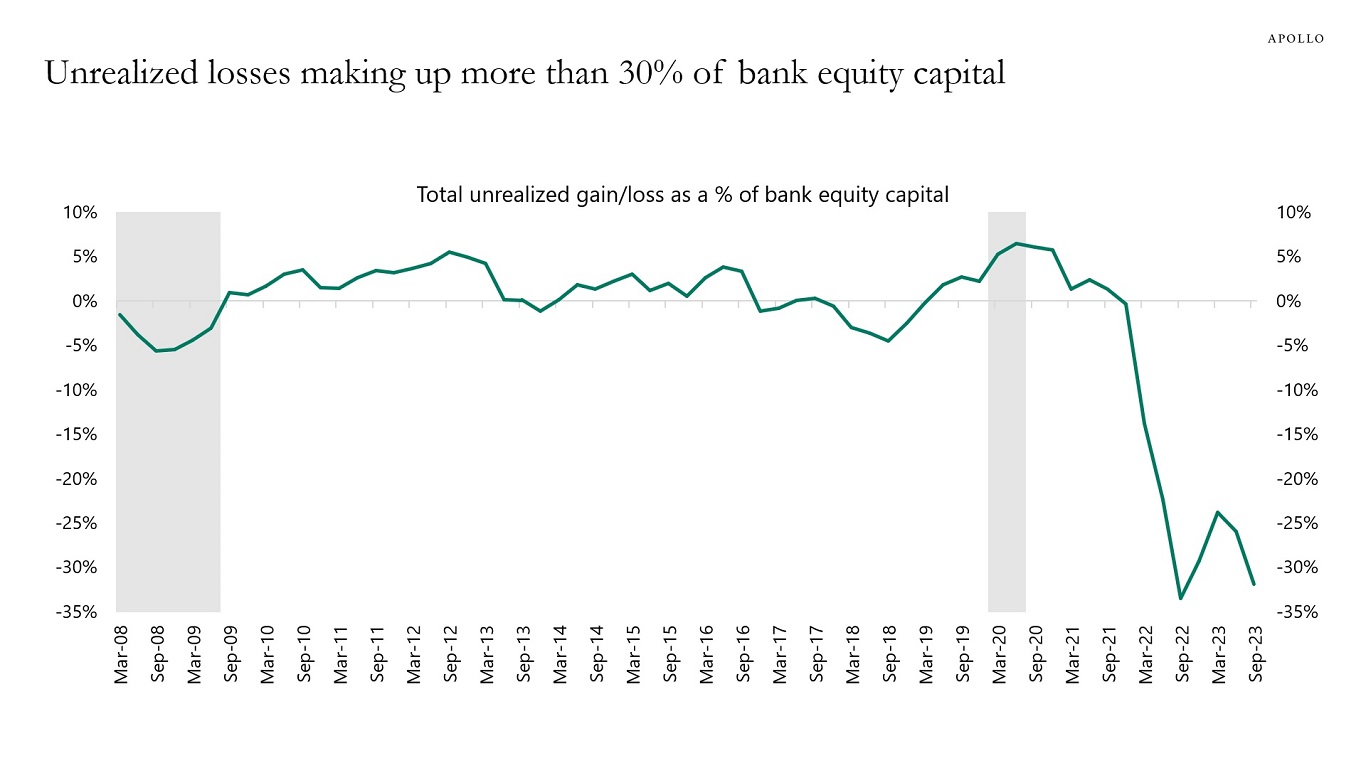
Source: FDIC, Haver Analytics, Apollo Chief Economist 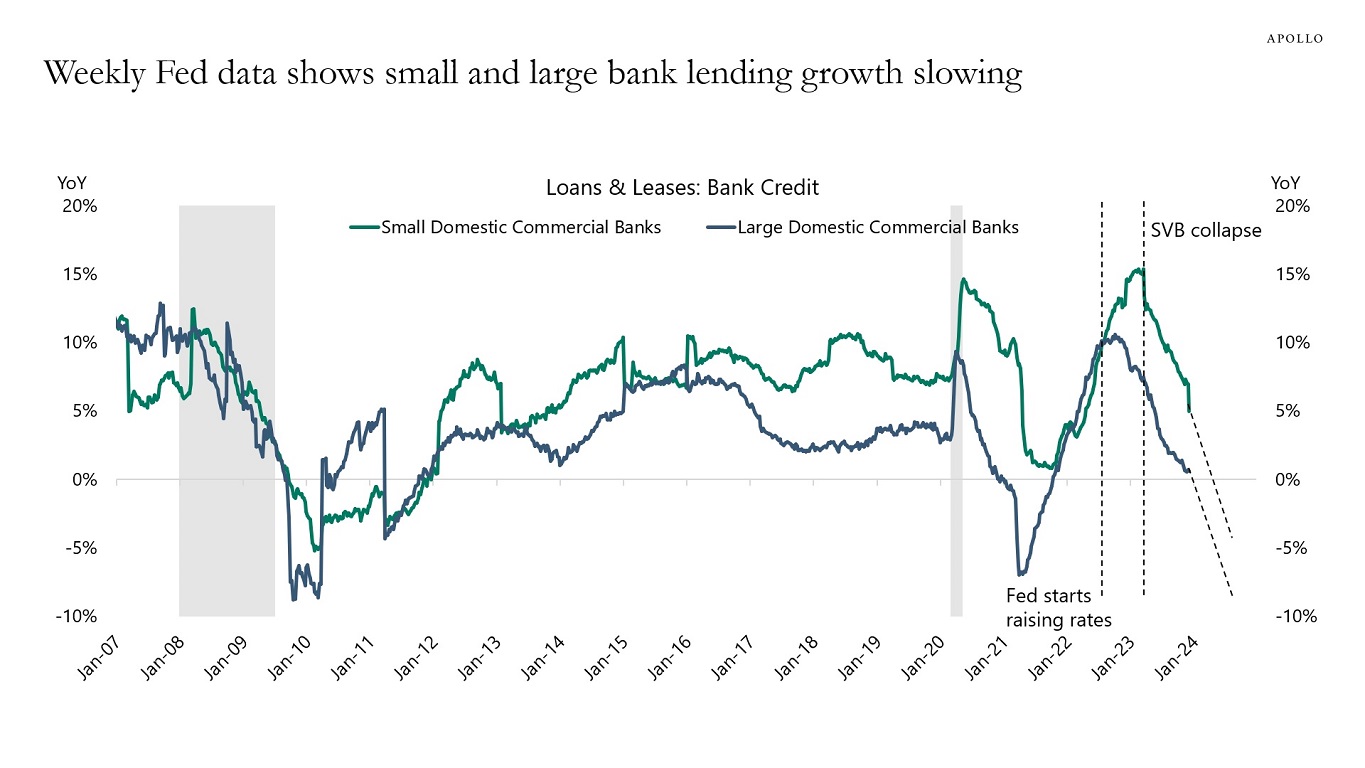
Source: Federal Reserve Board, Haver Analytics, Apollo Chief Economist See important disclaimers at the bottom of the page.
-
Recent issuance in IG, HY, and loans has focused on refinancing and general corporate purpose (GCP), but after the Fed pivot, we are likely to see an increase in M&A activity in 2024 driven by lower cost of capital and pent-up M&A, see charts below. Our latest credit market outlook is available here.
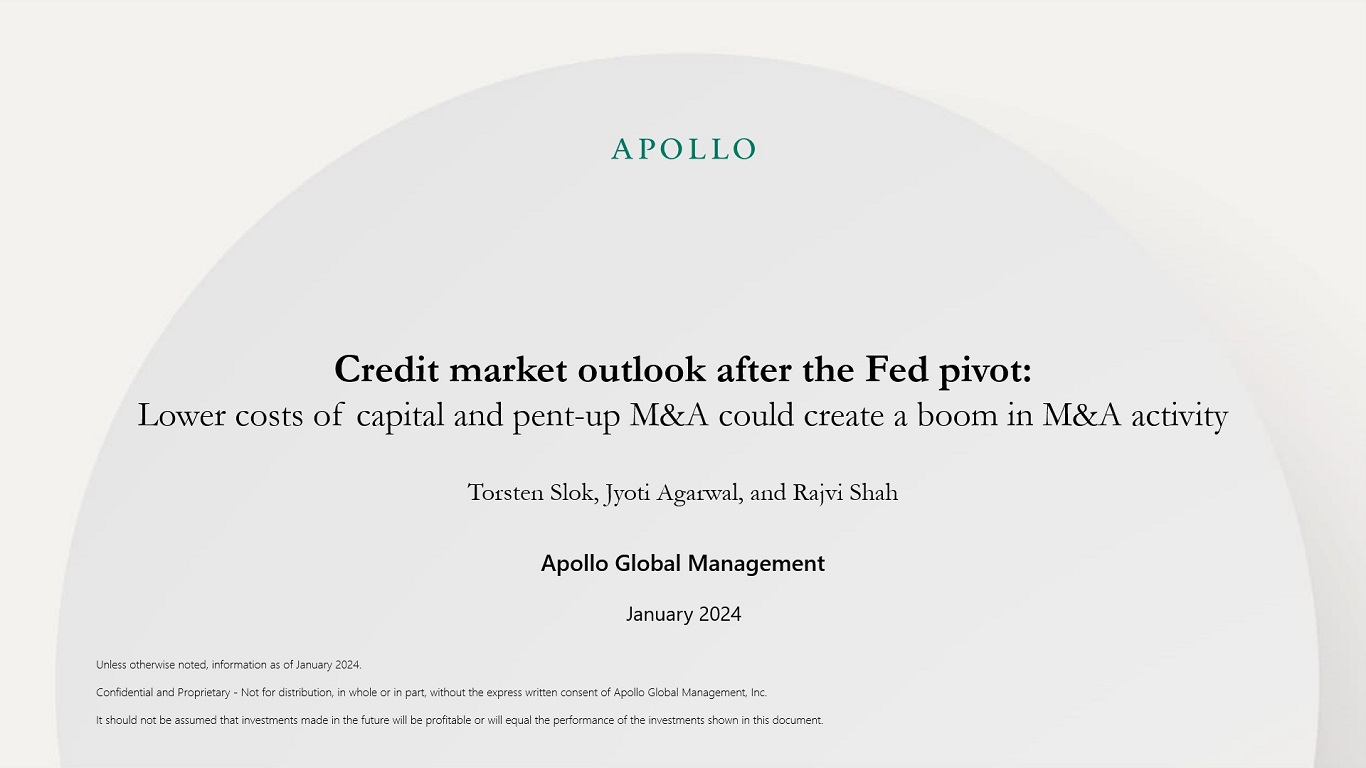
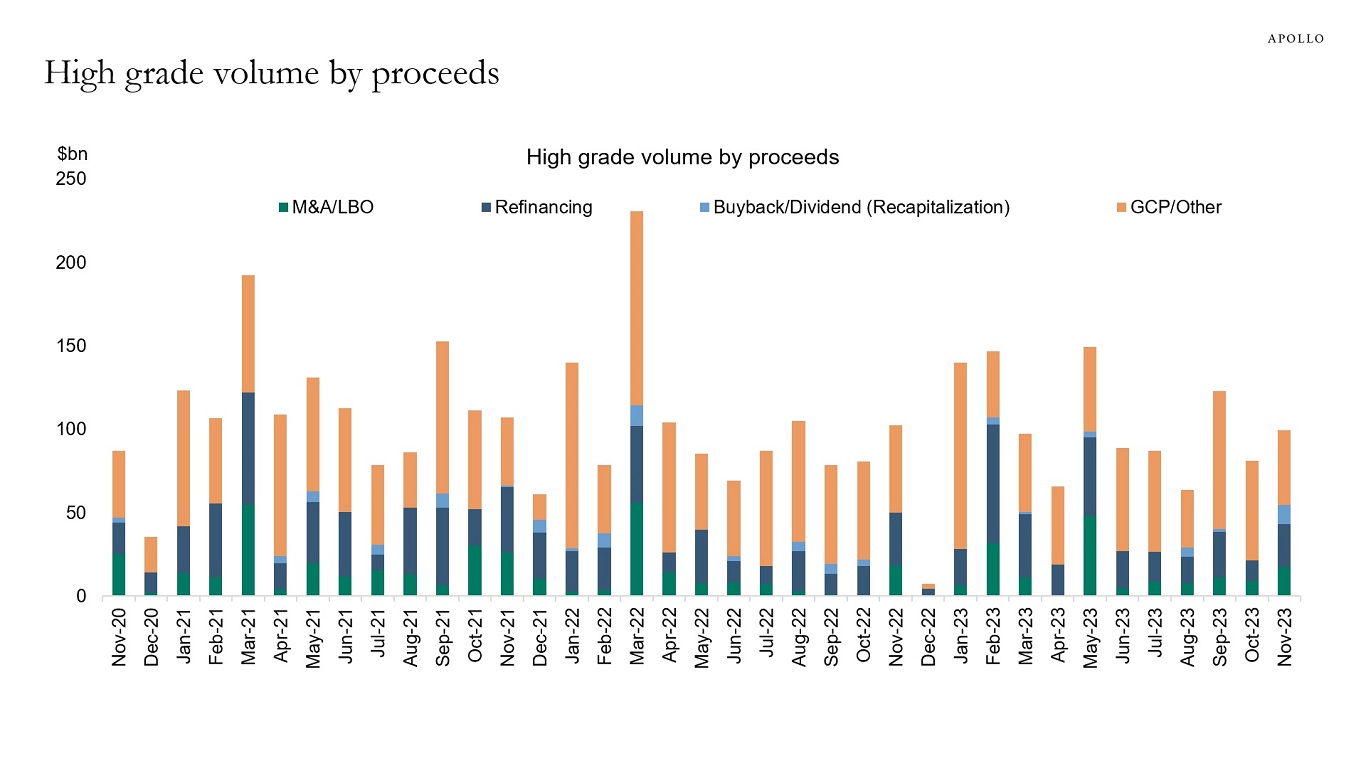
Source: Pitchbook LCD, Apollo Chief Economist. Note: GCP means General Corporate Purpose, which means making or financing any payment for working capital, capital expenditures, or any other general corporate purpose. 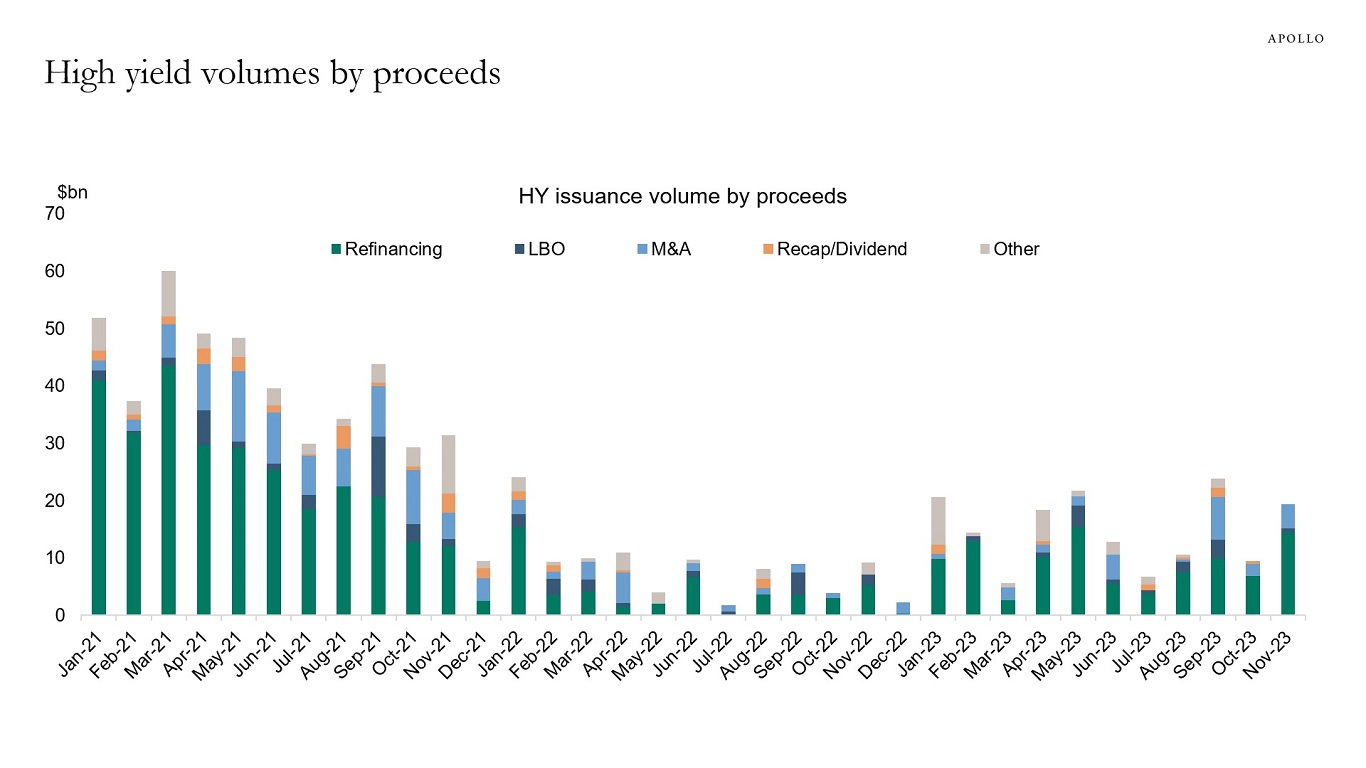
Source: Pitchbook LCD, Apollo Chief Economist 
Source: Pitchbook LCD, Apollo Chief Economist See important disclaimers at the bottom of the page.
-
The average negative equity for car owners has continued to increase and is now higher than in 2019, see chart below.

Source: Bloomberg, Apollo Chief Economist See important disclaimers at the bottom of the page.
-
The market cap of the Magnificent Seven is now the same size as the combined market cap of the stock markets in Japan, Canada, and the UK, see chart below.
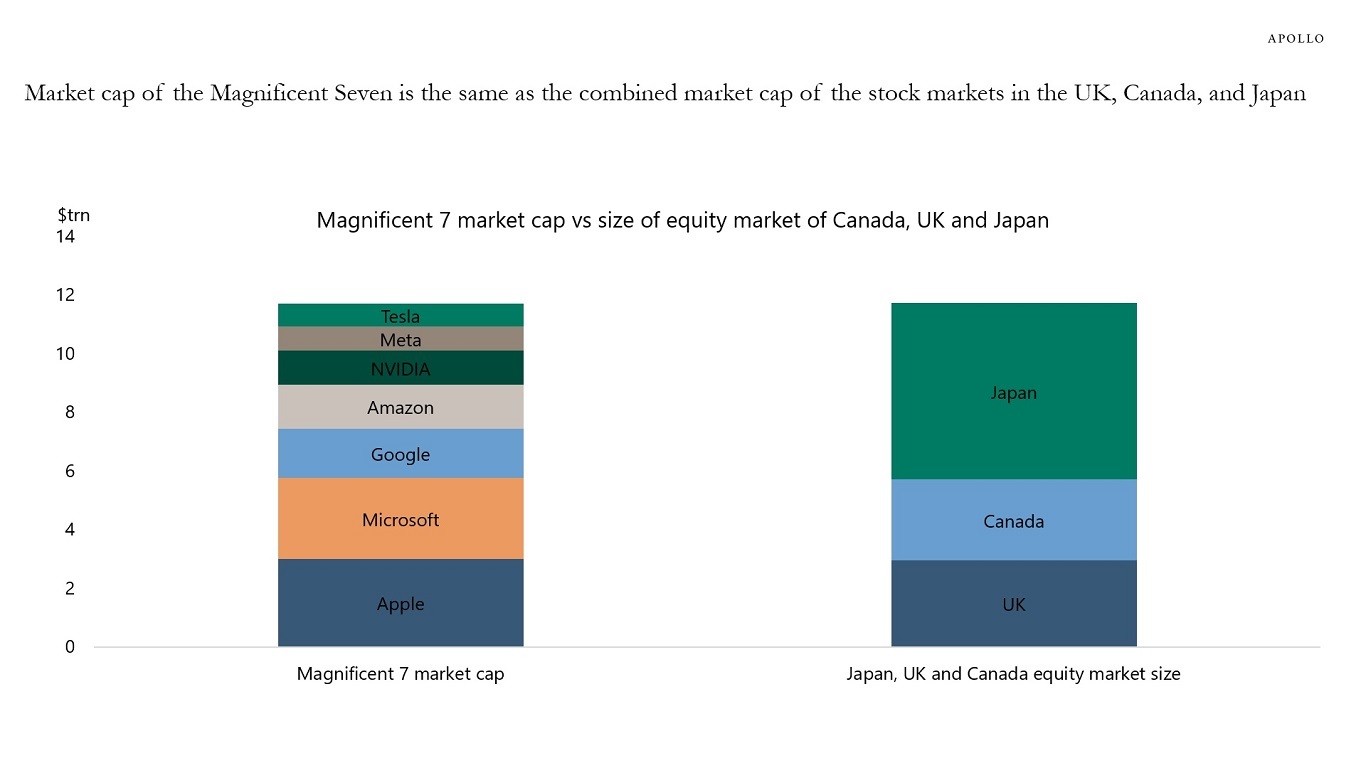
Source: Bloomberg, Apollo Chief Economist See important disclaimers at the bottom of the page.
-
The Fed pivot in December parallels what happened a decade ago.
In 2013, the taper tantrum triggered a quick tightening in financial conditions due to a modest change in Fed communication.
Today, we are seeing a similar significant change in financial conditions on the back of a modest shift in Fed communication, but with the opposite sign.
The Fed pivot in December was a modest change in Fed communication, but the subsequent easing in financial conditions has been dramatic.
As a result, 2024 will be the year of the lagged effects of Fed hikes versus the Fed pivot. If the Fed pivot continues to push mortgage rates lower, stock prices higher, and credit spreads tighter, we could get a solid rebound in the economy over the coming months, particularly in housing, which will trigger a rebound in employment growth, see chart below.

Source: BLS, Haver Analytics, Apollo Chief Economist See important disclaimers at the bottom of the page.
-
The US Treasury market is the same size as the combined government bond markets of China, Japan, UK, France, Italy, and Germany, see chart below.
The bottom line is that there is no substitute for the US Treasury market.
Looking into 2024, the list of upside risks to yields in the long end is long, with a big budget deficit, increasing Treasury issuance, the risk of a sovereign downgrade, the Fed doing QT, falling foreign demand for Treasuries, and a shift in issuance away from bills to coupons.
These forces are pushing long rates higher. But a dovish Fed pulls in the other direction.
Even if the Fed starts cutting rates, a steepener in the first half of 2024 seems most likely, with upside risks to long-term interest rates coming from factors unrelated to what the Fed will do.
In particular, if we get a soft landing in 2024, then both economic and non-economic forces could, by the end of 2024, push long-term interest rates higher than where they are today.

Source: BIS, Apollo Chief Economist. Note: Data for general government debt outstanding. Data for 2022. See important disclaimers at the bottom of the page.
This presentation may not be distributed, transmitted or otherwise communicated to others in whole or in part without the express consent of Apollo Global Management, Inc. (together with its subsidiaries, “Apollo”).
Apollo makes no representation or warranty, expressed or implied, with respect to the accuracy, reasonableness, or completeness of any of the statements made during this presentation, including, but not limited to, statements obtained from third parties. Opinions, estimates and projections constitute the current judgment of the speaker as of the date indicated. They do not necessarily reflect the views and opinions of Apollo and are subject to change at any time without notice. Apollo does not have any responsibility to update this presentation to account for such changes. There can be no assurance that any trends discussed during this presentation will continue.
Statements made throughout this presentation are not intended to provide, and should not be relied upon for, accounting, legal or tax advice and do not constitute an investment recommendation or investment advice. Investors should make an independent investigation of the information discussed during this presentation, including consulting their tax, legal, accounting or other advisors about such information. Apollo does not act for you and is not responsible for providing you with the protections afforded to its clients. This presentation does not constitute an offer to sell, or the solicitation of an offer to buy, any security, product or service, including interest in any investment product or fund or account managed or advised by Apollo.
Certain statements made throughout this presentation may be “forward-looking” in nature. Due to various risks and uncertainties, actual events or results may differ materially from those reflected or contemplated in such forward-looking information. As such, undue reliance should not be placed on such statements. Forward-looking statements may be identified by the use of terminology including, but not limited to, “may”, “will”, “should”, “expect”, “anticipate”, “target”, “project”, “estimate”, “intend”, “continue” or “believe” or the negatives thereof or other variations thereon or comparable terminology.






